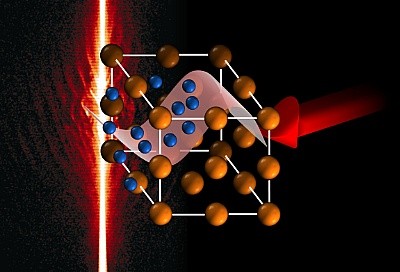A new class of high power lasers can effectively accelerate particles like electrons and ions with very intense, short laser pulses. This has attracted the interest of researchers around the globe, working out the details of the acceleration process which occurs when a laser beam impinges on a thin foil to accelerate ions from the foil’s rear surface to high energies. The electrons in the foil are heated by the laser pulse, thereby gaining energy. These electrons in turn give part of their energy to the ions, thereby converting laser pulse energy to ion energy. Physicists at the Helmholtz-Zentrum Dresden-Rossendorf (HZDR) have developed a new theoretical model for predicting the density and temperature of these hot electrons which surpasses existing models in accurately describing experimental results and simulations.
Particle acceleration by short, intense pulses of light is a modern technology which exhibits considerable advantages over conventional techniques: The distance needed for acceleration is much shorter and the costs for such systems are potentially much lower. The potentials of the new ion acceleration technology will be explored by a laser system which is currently under construction for use at the University Hospital in Dresden. It will be jointly used by the partners HZDR, the University Hospital, and TU Dresden for cancer research and therapy. For the first time ever, a prototype high performance laser will be used in addition to a conventional ion accelerator for radiation tumor therapy.
High power lasers like the DRACO laser at the Helmholtz-Zentrum Dresden-Rossendorf are about ten to a hundred times more intense than their predecessors for which theoretical estimates of electron temperature and density were more or less accurate. For the new generation of lasers, though, experimental findings considerably differ from predictions. Thomas Kluge, physicist in the Laser Particle Acceleration Division at the HZDR, together with his colleagues has developed a new theoretical model of laser electron interaction. Hot electrons serve as intermediaries in laser ion acceleration by transferring energy from the laser to the ions. Hence, precise information on the energy of hot electrons is vital for future laser-driven cancer therapy facilities.
Existing models have not been able to accurately predict the properties of hot electrons specifically at very high intensity – like the electrons generated by the high power laser DRACO and the petawatt laser PENELOPE which is currently under construction at the HZDR. The Dresden researchers have developed an equation that allows precisely calculating the hot electron energy by taking into account the distribution of laser accelerated electrons as well as their dynamics according to the theory of special relativity.
“These new insights surpass models that have been around for decades; thus, permitting, on the one hand, an explanation of previous measurements while, on the other hand, allowing for predicting and optimizing future experiments with great precision,” notes Michael Bussmann, Head of the HZDR’s Junior Research Group “Computational Radiation Physics.” The results were published in the scientific journal Physical Review Letters and are currently being applied to additional acceleration scenarios by the Dresden researchers in order to permit the future use of laser accelerators for medical use.



I work at the Hospital here in Dresden and found your site. Great to read something about our science. Regards, Stefan Mueller